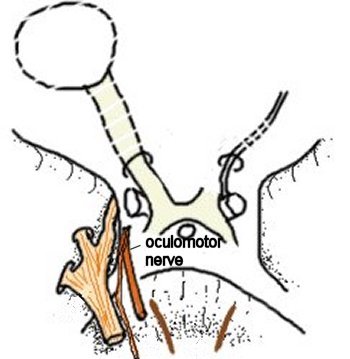oculomotor nerve

The oculomotor nerve is the third cranial nerve. It stimulates only motor functions. This nerve controls all the muscles that move the eye, except for two – the superior oblique muscle (which rotates the eyeball downward and outward and is controlled by the trochlear nerve) and the lateral rectus muscle (which moves the eye outward and is controlled by the abducens nerve). The oculomotor nerve also carries parasympathetic fibers to the muscles that constrict the pupil (sphincter pupilae), the ciliary muscle (which focuses the eye), and the muscle that raises the upper eyelid.
The oculomotor nerve arises from the brainstem and enters the dura mater to lie on the side wall of the cavernous sinus. The nerve enters the orbit through the superior orbital fissure.
 |
| The oculomotor nerve originates high in the brainstem and passes forward through a slit in the bony eye socket to reach the muscles that move the eye and eyelids. |
The oculomotor nerve may be damaged as a result of a fracture of the base of the skull or of a disorder that distorts the brain, such as a tumor. Depending on the severity of the damage, the following symptoms may occur: ptosis (drooping of the upper eyelid), squint, dilation of the pupil, inability to focus the eye, double vision, and slight protrusion of the eyeball.


